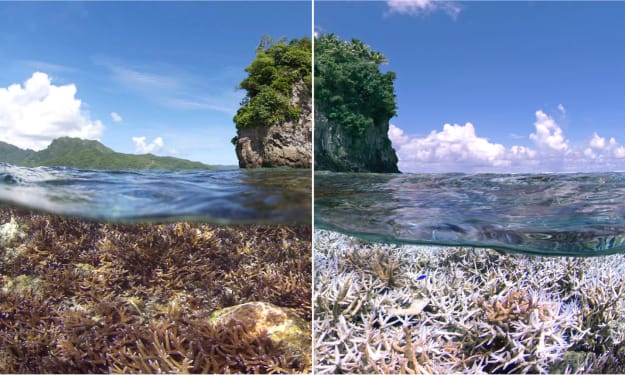Saving the Corals Is Important Work
Why coral reef conservation and restoration is a full-time job.

There are many ways to “work” in this world. When most think of what it means to work, it is perhaps most common to think of the ‘traditional’ 9-5. This is tied to the concept of a earning a livelihood through work. The Oxford English Dictionary defines work as, “to do something that involves physical or mental effort, especially as part of a job”. The very definition implies carrying out work in a transactional sense. Perform work to receive a paycheck.
But for some, to earn a livelihood is also to earn something beyond the monetary. There is in an intrinsic value in performing the work for something outside of the financial. For me, this is where the work I do in this world has the most value. The work I do in coral restoration is this type of work.
It is not something I do currently in exchange for money. It is something I do because I am passionate about it, and I am privileged to have the time to do it, in addition to a job that earns money. I understand what it would mean to live in a world without coral, and I know this isn’t where I would choose to live. It would mean a world without life-saving biodiversity, critical environmental infrastructure. The work I do is meaningful because it helps me to make an impact, however small, in the fate of our planet.
If someone had asked me if I thought one of my first loves would be a coral reef rather than a human, I would have thought they were joking. But much like many can remember meeting their first partner in vivid detail, I have a similarly vivid memory of the first time I saw a coral reef. I had just become PADI-certified and clear to dive a maximum of 18 metres/60 feet. This meant the majority of the local coral reefs were fair game for diving, and ripe for exploration.
My first dive was beyond words. I bore witness to an entirely new world—unlike any I had ever seen. Photographs did not do it justice, and videos were just the same: simply inadequate to capture the beauty, the essence, the living, breathing Universe that lay below. I remember marvelling at the corals and the multitudes of different kinds. Some looked like elk horns, others like brains. All were magical. I learned later that they were appropriately named—elkhorn and brain coral.
I also learned that they were dead. Or mostly dead, anyway.
What I thought were beautiful specimens of lively coral were either the equivalent of walking corpses, or were already a bag of bones. Most exhibited signs of bleaching, a precursor to their death, or had been long gone already, leaving only the skeleton in their wake.

Learning this was like how it feels to learn you or a loved one has a terminal illness. There is a feeling of hopelessness and despair, and a desperate want to help improve the situation, no matter how unfavorable the odds. So this is what I did.
I worked with local nonprofits, the scientific diving community, and later, independently, to help restore our coral reefs. The work started when I began my scientific diving training which not only equipped me with the essential skills of gathering data underwater in challenging conditions, but introduced me to an incredible group of friends and professionals dedicated to marine preservation.
Getting up early to wear a wetsuit in the tropical heat was motivated by my love for the water and the world it held within it. The conditions were often difficult. Hot and murky with water thick enough with dirt you couldn’t see your hand when it was directly in front of your face. But knowing the reasons why I was doing the work helped me push through.
It was during my training that I learned that worldwide, more than 500 million people depend on coral reefs for food, income, coastal protection, and more. They only cover around 2% of the ocean floor, but over a quarter of all marine life, and over half of all life on Earth, depends on them to survive. They’re also like a modern medicine chest. Corals are used in the treatment of cancer, HIV, heart disease, and more ailments. Keeping the corals alive means not only helping the ocean, but saving lives, too. This is why my work, and the work of all restoration efforts around the world, is important. It may not earn me a living, but my life quite literally depends on it. As do all of ours.
When time merits, I volunteer for a local nonprofit which helps to restore coral reefs. We tend to the underwater coral farm, plant the coral reefs, and help with data collection and coral type tagging. The nonprofit has a veritable ‘Noah’s Ark’ of coral types in the farm, and they gather data on the genetic composition of the reefs to better understand how the environment impacts the coral’s hardiness to environmental changes such as rising ocean temperatures and salinity levels. I enjoy volunteering with them, as it helps me to make an impact, however small, on helping to improve the viability of our coral reefs.
Here's a short video showing our day with the Coral Restoration Foundation:
My work doesn’t stay below the water, however. I am actively refining a tool to help identify coral bleaching with the hopes of better understanding the dynamics which both create, and ameliorate, the phenomena. I have an existing prototype utilizing artificial intelligence (AI) which successfully identifies two critically endangered (CR) coral types, Elkhorn Coral, Acropora palmata, and Staghorn Coral, Acropora cervicornis, and whether they are bleached or healthy. This is essential, as being able to identify bleached corals is the first step to understanding their environment, the underlying factors behind their bleaching, and how to target them for conservation and restoration efforts.
I am working on a complementary tool to help aggregate and analyze data about the environmental conditions of different coral habitats, too, to better understand how to predict coral bleaching or rejuvenation. It is work which fulfills me, and gives me a sense of purpose. The world has lost half its reefs in the last 30 years, and scientists estimate 90% loss by 2050. This is unacceptable. Corals have survived the dinosaurs and countless other extinctions. Any small role I can help to play in adding them to the list is work I will always clock in for.
About the Creator
E.K. Daniels
Writer, watercolorist, and regular at the restaurant at the end of the universe. Twitter @inkladen






Comments
There are no comments for this story
Be the first to respond and start the conversation.